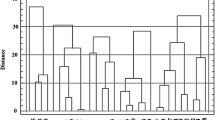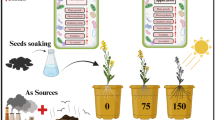Abstract
Twenty five genotypes of oilseed rape (canola and mustard) were tested under varied supply of Zn (+Zn: 2 mg kg−1 soil, -Zn: no Zn added) in two pot experiments in soil culture to determine the genotypic variation in tolerance to the Zn-deficient conditions, that is, to identify the Zn-efficient genotypes. On the basis of performance of genotypes in pot experiments, ten genotypes were tested in 1995 for their performance under varied supply of Zn (+Zn: 3.5 kg ha−1, -Zn: no Zn added) on a Zn-deficient field in South Australia.
Zn efficiency (ratio of shoot dry matter in -Zn to shoot dry matter in +Zn treatment and expressed in percentage) in pot Experiment 1 varied from 35% for 92-13 to 74% for Siren. Narendra, Dunkeld, Barossa, Oscar and Xinza 2 performed well under -Zn treatment. Zn efficiency in Experiment 2 varied from 32% for Wuyou 1 to 62% for Pusa Bold. Pusa Bold and CSIRO-1(mustard genotypes) were the most efficient in terms of dry matter production among all the oilseed rape genotypes tested. Root dry matter accumulation was significantly higher in Zn-efficient genotypes. Zn efficiency (ratio of seed yield in -Zn to seed yield in +Zn and expressed in percentage) in field experiment varied from 62% for Huashang 2 to 76% for Dunkeld. With few exceptions, the ranking of genotypes in pot and field experiments indicates similarity in their response to Zn deficiency. There looks to be genetic control over Zn concentration in tissues. Zn-efficient genotypes had lower Zn concentration in roots and higher Zn concentration in youngest fully opened leaf blades, indicating a better transport of Zn. This, together with a higher Zn uptake, appears to be the basis of expression of Zn efficiency.
Similar content being viewed by others
References
Cakmak I and Marschner H 1988 Increase in membrane permeability and exudation in roots of zinc deficient plants. J. Plant Physiol. 132, 356-361.
Foy C D 1983 Plant adaptation to mineral stress in problem soils. Iowa State J. Res. 57, 355-391.
Fu-Cheng R, Tie-Ching L, Liu H Q and Hu B Y 1993 Influence of zinc on the growth and distribution of elements on genseng plants. J. Pant Nutr. 16, 393-405.
Graham R D 1984 Breeding for nutritional characteristics in cereals, Adv. Plant Nutr. I 57-102.
Graham R D 1991 Breeding wheats for tolerance to micronutrient deficient soils: present status and priorities. InWheat for the non traditional warm areas. Ed. D A Saunders. pp 315-332. CIMMYT, Mexico D.F.
Graham R D, Ascher J S and Hynes S C 1992 Selecting zinc-efficient genotypes for soils of low zinc status. Plant Soil 146, 241-250.
Graham R D and Rengel Z 1993 Genotypic variation in zinc uptake and utilization by plants. InZinc in Soils and Plants. Ed. A D Robson. pp 107-118. Kluwer Academic Publishers, Dordrecht.
Hartwig E E, Jones W F and Kilen T C 1991 Identification and inheritance of inefficient zinc absorption in soybean. Crop Sci. 31, 61-63.
Jolley V D and Brown J C 1991 Factors in iron-stress response mechanism enhanced by zinc-deficiency stress in Sanilac, but not Saginaw navy bean. J. Plant Nutr. 14, 257-266.
Liu Z, Zhu Q and Tang L 1990 Soil trace elements. InThe Soil of China. pp 621-635. Science Press, Beijing.
Nable R O and Webb M J 1993 Further evidence that zinc is required throughout the root zone for optimal plant growth and development. Plant Soil 150, 247-253.
Ramani S and Kannan S 1985 An examination of zinc uptake patterns by genotypes of sorghum and maize; Differences amongst hybrids and their parents. J. Plant Nutr. 8, 1199-1210.
Rashid A, Buthio N and Rafique E 1994 Diagnosing zinc deficiency in rapeseed and mustard by seed analysis. Commun. Soil Sci. Plant Anal. 25, 3405-3412.
Rengel Z and Graham R D 1995 Importance of seed Zn content for wheat growth on Zn-deficient soil. I. Vegetative growth. Plant Soil 173, 259-266.
Robson A D and Snowball K 1989 The effect of 2-(4-2′, 4′-dichlorophenoxy-phenoxy)-methyl propanoate on the uptake and utilization of zinc by wheat. Aust. J. Agric. Res. 40, 981-90.
Robson A D and Snowball K 1990 The effect of chlorosulfuron on the uptake and utilization of copper and zinc in wheat. Aust. J. Agric. Res. 41, 19-28.
Saxena S C and Chandel A S 1992 Effect of zinc fertilization on different varieties of soybean (Glycine max). Indian J. Agric. Sci. 62, 695-697.
Saxena N B and Mathur S K 1987 Effect of available zinc on the productivity of Phaseolus aconitifoliusgenotypes. Proc. Nat. Symp. Micronutrient Stresses in Crop Plants, MPKVV, Rahuri. 124 p.
Sharma U C and Grewal J S 1990 Potato response to zinc as influenced by genetic variability. J. Indian Potato Assoc. 17, 1-5.
Takkar P N 1991 Zinc deficiency in Indian soils and crops. InZinc in Crop Nutrition. Int. Lead Zinc Res. Org. Inc. and Indian Lead Zinc Information Centre, New Delhi. pp 55-64.
Takkar P N 1993 Requirements and response of crop genotypes to micronutrients in India-a-review. InGenetic Aspects of Plant Mineral Nutrition, Eds. P J Randall, E Delhaize, R A Richards and R Munns. pp 341-348. Kluwer Academic Publishers, Dordrecht.
Takkar P N and Walker C D 1993 The distribution and correction of zinc deficiency. InZinc in Soils and Plants. Ed. A D Robson. pp 151-165. Kluwer Academic Publishers, Dordrecht.
Tiwari K N and Dwivedi B S 1990 Response of eight winter crops to zinc fertilizer on a Typic Ustochrept soil. J. Agric. Sci. (Camb) 115, 383-387.
Welch R M, Webb M J and Loneragan J F 1982 Zinc in membrane function and its role in phosphorous toxicity. InProc. 9th Int. Coll. Plant Nutrition. Ed. A Scaife. pp 710-715. Common w. Agric. Bur., Farnham Royal.
Welch R M and Norvell W A 1993 Growth and nutrient uptake of barley (Hordeum vulgareL. cv Herta). Studies using an N-(2-hydroxyethyl)ethylenedinitrilotriacetic acid-buffered nutrient solution technique. 1. Role of zinc in the uptake and root leakage of mineral nutrients. Plant Physiol. 101, 627-631.
Zarcinas B A, Carwright B and Spouncer L R 1987 Nitric acid digestion and multi-element analysis of plant material by inductively coupled plasma spectrometry. Commun. Soil Sci. Plant Anal. 18, 131-146
Zhang F, Romheld V and Marschner H 1989 Effect of zinc deficiency in wheat on the release of zinc and iron mobilizing root exudates. Z. Pflanzenernaehr. Bodenkd. 152, 205-210.
Zhang F, Romheld V and Marschner H 1991 Release of zinc mobilizing root exudates in different plant species as affected by zinc nutritional status. J. Plant Nutr. 14, 675-686.
Author information
Authors and Affiliations
Rights and permissions
About this article
Cite this article
Grewal, H.S., Stangoulis, J.C., Potter, T.D. et al. Zinc efficiency of oilseed rape (t Brassica napus and t B. juncea) genotypes. Plant and Soil 191, 123–132 (1997). https://doi.org/10.1023/A:1004289422276
Issue Date:
DOI: https://doi.org/10.1023/A:1004289422276




